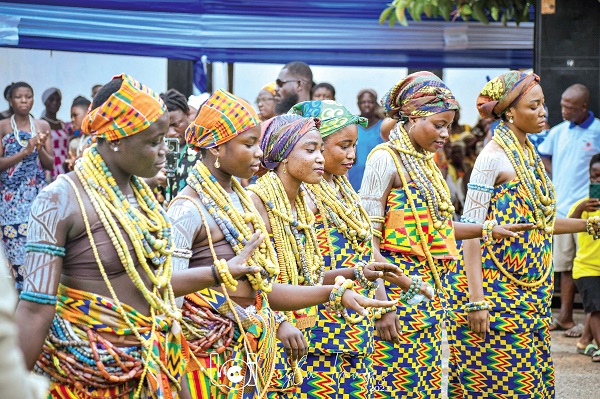![]()

Klama, an indigenous Dangme music and dance
Klama is an age-old sacred folk music and dance indigenous to the Dangme people. Research and oral lore have shown that it emerged and evolved as the people migrated from the eastern section of West Africa to their present locations.
Therefore, all seven Dangme sub-tribes made up of Krobo (Yilo and Manya Krobo) in the Eastern Region; Ada, Sɛ, Gbugbla, Ningo, Kpone and Osudoku in the Greater Accra Region perform klama.
There is, however, a slightly noticeable variation in the rhythm and gestural movements as one explores the rhythm and dance from one sub-tribe to the others.
While its popularity and the regularity of its use during occasions appear to be on the decline in some of the traditional areas for varied reasons, including the impact of Christianity, modernity and scarcity of skilled drummers, in a place like Krobo, klama remains a regular feature of important ceremonies and rites.
When it is performed
Klama is performed mainly as a form of recreation and to give a cultural touch to festive occasions including joyous family gatherings and anniversary celebrations, marriage and naming ceremonies, enstoolment and outdooring of traditional leaders (chiefs and queens), the dipo puberty rites and larger cultural festivals, among others.
Though it is more associated with festivities, klama can be performed at some somber events such as the funeral of persons with traditionally sacred authority or duty, such as dipo (traditional) priests and chiefs; but this rarely occurs.
The klama musical instruments
The klama rhythm or beat is composed of sounds from a gong (a metallic disc with a turned rim that gives a resonant note when struck to dictate the pace of a particular beat), casaba of gourd or beaded gourd, known locally as 'fau', which is a percussion instrument from a dried gourd, with beads woven into a net covering it.
The gong and beaded gourd are complemented by a set of three drums – a long cylindrically shaped drum called Gl3 or Mi3 gaga, which largely directs the rhythmic and gestural movement of the dancer; Oklema, the smallest of the drums, which produces a high-pitched sound, and a relatively shorter drum with a much deeper sound called Opiti or ‘kpɛti miɛ’.
What mainly distinguishes a festive klama from the type that is seldom performed at sombre events is the choice of songs. Klama songs are lyrically rich, figurative and event-specific; they have a very unique structure and cadence that takes a considerable period of practice for a singer to master the modulation and inflexions needed to proficiently lead a chorus; and they are carefully chosen to reflect the nature and mood of specific events.
While the festive songs extol virtues and talk about positive themes such as culture, tradition, wealth, beauty, blessings, good health, unity and fortune, those sung at funerals are generally solemn and tend to evoke or reflect feelings of pensive sadness.
They are usually composed around subjects such as the inevitability and overbearing nature of death, the afterlife or the worth of the personality lost to the ancestral world and the impact of the loss on the living.
There are also generic songs that are laced with idiomatic expressions and innuendos for lighter moments. One can also find songs composed on subjects such as herbalism, femininity, culture and tradition. Some are employed to tell stories about the people’s migration, historic events or exploits of great warriors/martyrs and other similarly great personalities. Most of these songs are, however, of unknown authorship and are largely orally transmitted.
The rhythms, steps and gestural movements
Klama is gender-neutral; both sexes can drum and dance to the same rhythm of the klama music, except that the gestural movements for females are more metrical, characterised by a slow graceful and rhythmic body movement and the shuffling of the feet. The left arm is raised horizontally, a little above the waist level and the wrist is wriggled mildly in tune with the beat while the right arm, which points downwards, swings gently in conformity. Unlike the females’ which is ‘sluggish’, the males’ version requires a more complex combination of rapid, sprightly and dexterous footwork or shuffling of feet.
There are short movements that require the dancer to dance in place and travelling movements that either take the performer a few steps away from the instrumentalists or require the use of the entire performance arena. Dancing can be in groups and a dancer can go solo as well, depending on the occasion and the number of performers.
Dipo and Klama - the distinction
Many, particularly persons who have not had sufficient acquaintance with the culture and tradition of the Dangme people, continue to confuse klama and dipo. It is quite common to hear people wrongly use the two interchangeably. Though the two are inseparably linked and are both of Dangme origin, they are quite distinct.
While Klama is merely a piece of music and dance, dipo is a whole transitional rite involving a chain of rituals performed for nubile girls to, among others, usher them into adulthood and also enable them to obtain ‘full status’ in their tribal (Dangme) communities.
The writer is a Public Relations/Development Communication practitioner, a freelance journalist, an activist writer, a blogger, an incurable social worker and a culture enthusiast from Odumase-Krobo. Email: klonobi2007@gmail.com
